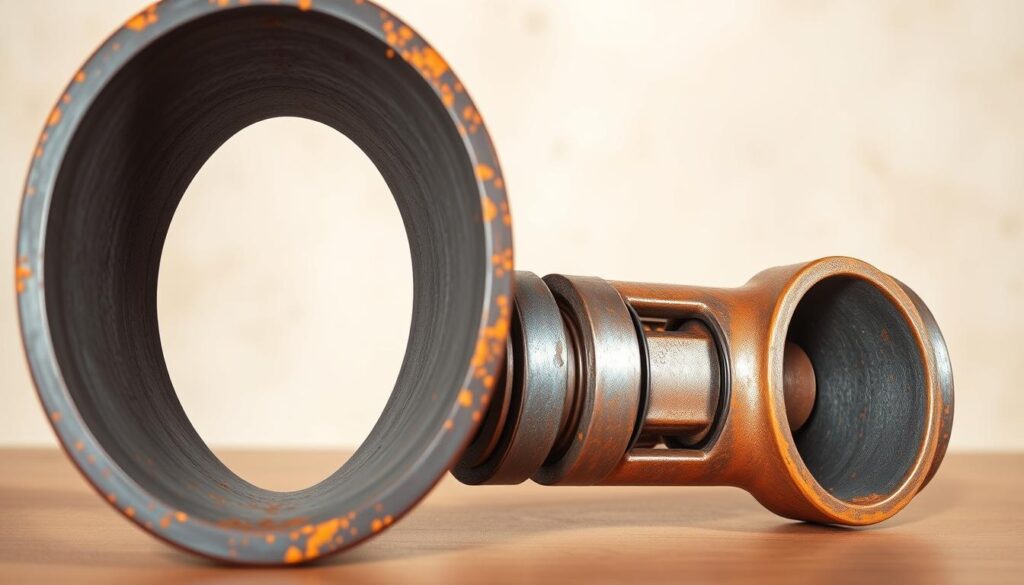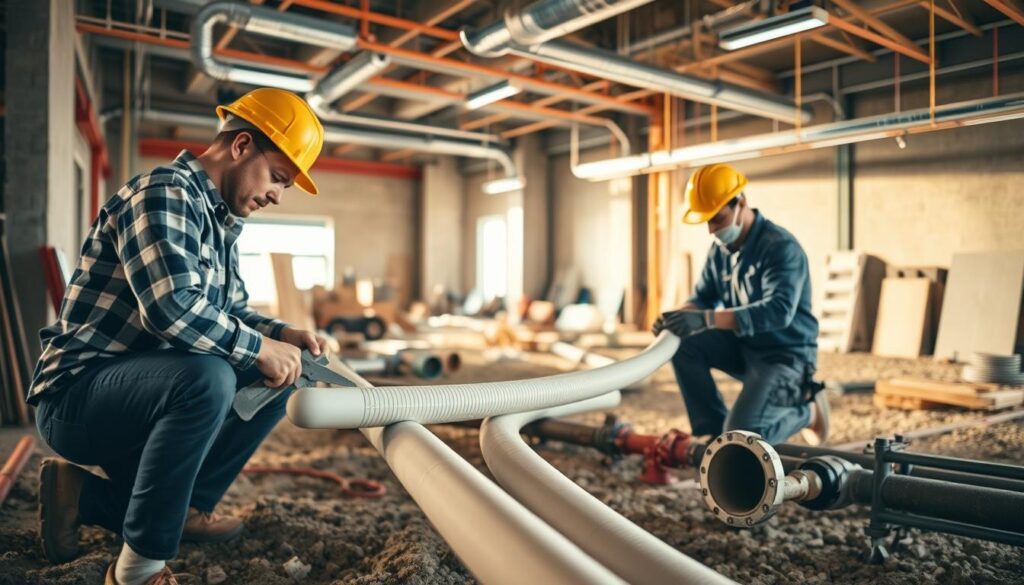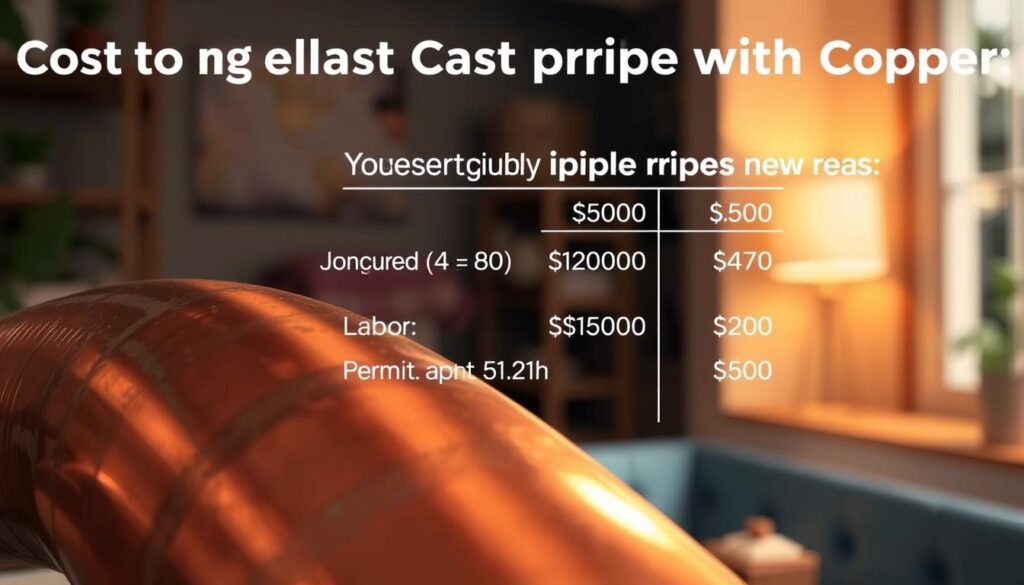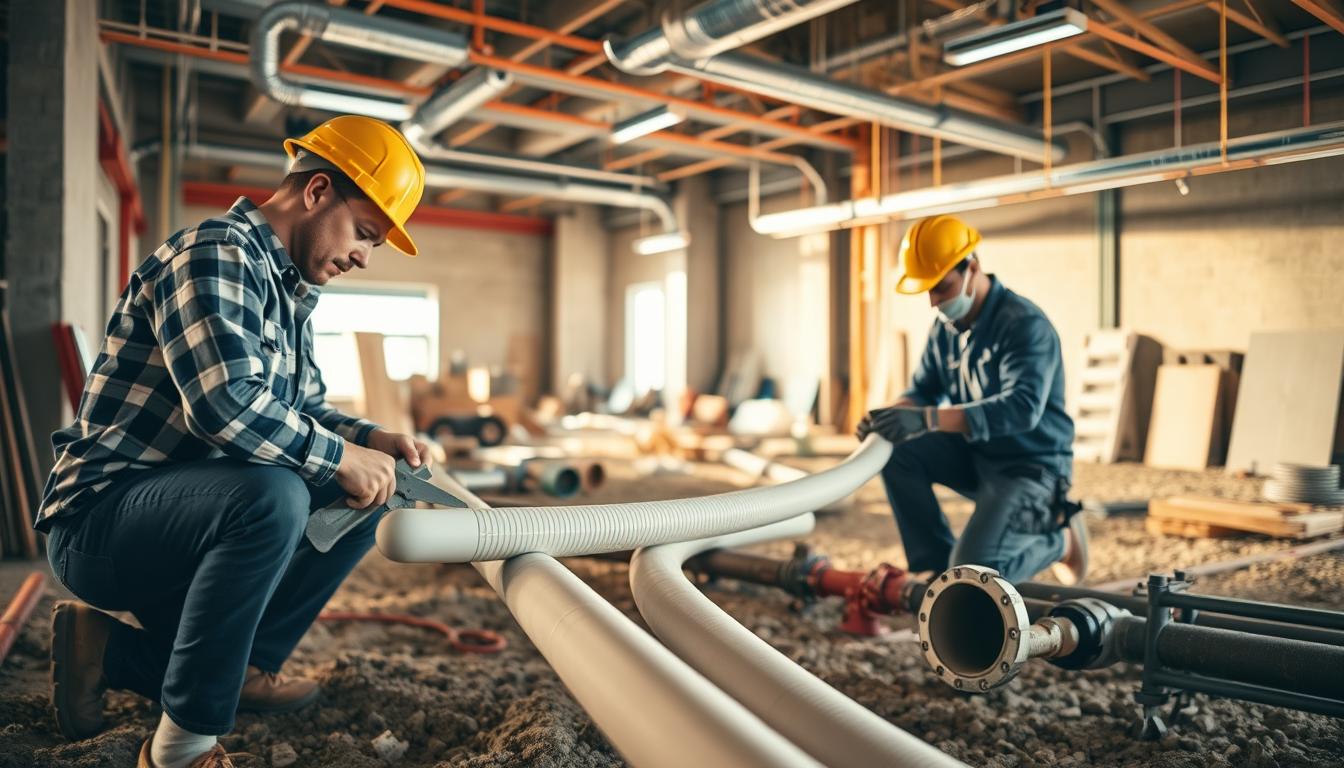Replacing cast iron pipes can be a big expense for homeowners. The cost can range from $3,000 to $10,000 or more. This depends on the job’s complexity and the house’s size and location. Knowing the cost helps homeowners make smart choices about their plumbing.

Introduction to Cast Iron Pipe Replacement
Many homeowners worry about the cost of replacing cast iron pipes. The cost can vary a lot. Homeowners might spend between $3,000 to $10,000 or more, based on the job’s complexity and the replacement material. Understanding this cost is key to deciding whether to replace or repair the pipes.
Key Takeaways
- The average cost to replace cast iron pipes ranges from $3,000 to $10,000 or more.
- The cast iron pipe replacement cost varies depending on the size of the house and the location of the pipes.
- Homeowners should consider the type of replacement material used when calculating the cast iron pipe replacement cost.
- Replacing cast iron pipes can be a significant investment, but it’s essential for maintaining a safe and functional plumbing system.
- Understanding the factors that affect the cast iron pipe replacement cost can help homeowners make informed decisions about their plumbing system.
Understanding Cast Iron Pipe Replacement
Cast iron pipes have been around for centuries in plumbing. But, they don’t last forever. Replacing them can be expensive, so it’s key to know the process and options.
Homeowners often ask why they need to replace cast iron pipes. It’s because they last from 50 to 100 years. But, damage, corrosion, or bad installation can shorten their life. Regular checks can help, but replacement is needed eventually.
Common Signs of Failure
- Leaks and water damage
- Corrosion and rust
- Low water pressure
When looking at cast iron pipe replacement, the cost is a big factor. This cost changes based on location, house size, and replacement material. Knowing the signs of failure and options helps homeowners make smart choices for their plumbing.
Choosing the right material and a professional plumber is key for a successful replacement. This will make your plumbing better and increase your property’s value.
How Much Does It Cost to Replace Cast Iron Pipes: Average Expenses
The cost to replace cast iron pipes with PVC or PEX varies a lot. It can be between $3 to $15 per foot. Replacing cast iron pipes with PEX is often cheaper because PEX resists corrosion and is easy to install.
When looking at the cost to replace cast iron pipes with PVC, remember to include material, labor, and permit costs. The total price depends on the project size, number of pipes, and installation difficulty.
Using PVC or PEX pipes has many benefits. They are durable, resistant to corrosion, and easy to install. These pipes also rarely leak and can handle high water pressure. Here are some average costs for replacing cast iron pipes:
- Material costs: $3 to $10 per linear foot
- Labor costs: $2 to $5 per linear foot
- Permit costs: $100 to $500, depending on the location and complexity of the job
Replacing cast iron pipes with PVC or PEX is a big investment. But it’s crucial for your plumbing system’s safety and integrity. By picking the right materials and hiring a skilled plumber, you can get a modern, efficient plumbing system.
Factors Affecting Replacement Costs
When looking at cast iron pipe replacement options, it’s key to know what affects the cost. The size and layout of a house are big factors. Larger homes with more complex plumbing systems cost more to replace.
The location and how easy it is to get to the pipes also matter a lot. Pipes in hard spots, like under the foundation or in walls, need special tools and skills. This makes the cost go up. Also, prices can vary by region, so it’s smart to check prices in your area.
Some important things to think about when looking at the cost of replacing cast iron pipes with copper are:
- Material costs in your area
- Regional price variations for labor and materials
- House size and layout complexity
- Pipe location and accessibility
By knowing these factors and looking at local prices, homeowners can make smart choices. They can find the best deal for their cast iron pipe replacement needs.
Types of Replacement Materials Available
Homeowners have many options when replacing cast iron pipes. The cast iron pipe replacement process can be customized to fit your needs and budget. A popular choice is PEX, known for its flexibility and resistance to corrosion and freezing.
Other materials like PVC, copper, and galvanized steel are also available. Each has its own advantages and disadvantages. For instance, PVC is affordable and easy to install, while copper is more expensive but durable and resistant to corrosion.
When choosing a replacement material, consider a few key factors:
- Cost: Think about the initial cost and any future maintenance or repair expenses.
- Durability: Look at how well the material withstands corrosion, freezing, and other environmental factors.
- Ease of installation: Consider how complex and costly the installation process is.
Understanding the different materials can help homeowners make the best choice for their needs and budget. Replacing cast iron pipes with PEX or other materials can improve your home’s plumbing system efficiently. The cast iron pipe replacement process can be done with little disruption to your daily life.

Timeline and Process Breakdown
The cast iron pipe replacement process has several steps. It starts with an assessment and ends with final inspections. Knowing this can help homeowners get ready for the replacement. It’s also important to hire a licensed plumber to ensure the job is done right and safely.
The first step is the pre-replacement assessment. This helps find out how bad the damage is and what to do next. The plumber will check the pipes, find any leaks or damage, and suggest the best repairs or replacements.
Pre-replacement Assessment
- Inspection of pipes to identify leaks or damage
- Determination of the best course of action for repairs or replacements
- Recommendations for the most suitable replacement materials
Installation Steps
After the assessment, the installation starts. This means taking out the old cast iron pipes and putting in new ones. Replacing cast iron pipes yourself can be tough. It’s best to get a professional plumber to do it right.
Post-replacement Inspections
After everything is installed, a final check is needed. This makes sure the new pipes work well. It’s important to catch any problems early to avoid future issues.
Insurance Coverage and Financing Options
Replacing cast iron pipes can be expensive, especially if you choose copper. The cost depends on your home’s size and the job’s complexity. Getting a plumber adds to the cost. But, there are ways to cover these expenses.
Homeowners might get insurance to cover the cost of replacing pipes. Check your policy to see what’s covered. Some policies help if damage happens suddenly, like a burst pipe.
Financing Options
- Payment plans: Plumbing companies might let you pay over time.
- Government assistance programs: You might get help if you qualify.
- Low-interest loans: Some loans have low interest for home repairs.
It’s important to know the details of any financing deal. Look at the interest rate, how you’ll pay back, and any fees. By looking into these options, you can handle the cost of replacing your pipes.

DIY vs Professional Installation
Homeowners face a choice when replacing cast iron pipes: DIY or hiring a plumber. DIY might save money, but it can be risky. It might also void the warranty on new materials.
Here are some pros and cons of each approach:
- DIY cast iron pipe replacement: can be cost-effective, allows for flexibility in scheduling
- Hiring a plumber for cast iron pipe replacement: ensures the job is done correctly and safely, provides warranty coverage
It’s important to think about the job’s complexity, your skills, and the risks. Hiring a licensed plumber can give you peace of mind. It ensures the job is done right and safely.
In conclusion, DIY might seem appealing, but it’s key to weigh the risks and benefits. By hiring a plumber for cast iron pipe replacement, you get a job done right. It’s safe and comes with warranty coverage.
Choosing the Right Plumbing Contractor
Choosing the right plumber for cast iron pipe replacement is crucial. It affects the durability and efficiency of your plumbing system. A skilled plumber will do the job right, avoiding future problems and expensive repairs.
To find the right plumber, look for a licensed one with experience in cast iron pipe replacement. Checking online reviews and asking for referrals from friends and family can help. Also, get multiple quotes to find the best value.
- License and certification
- Insurance and bonding
- Experience with cast iron pipe replacement
- Good reputation and online reviews
By researching and choosing a qualified plumber, you’ll have a successful cast iron pipe replacement. You’ll enjoy the long-term benefits of a well-working plumbing system.
Long-term Cost Benefits of Replacement
Replacing cast iron pipes can save money in the long run. It reduces the chance of leaks, corrosion, and damage to your property. New pipes are made to last, cutting down on repair and replacement needs.
Replacing pipes can also lower your water bills and insurance costs. Plus, it can make your property more valuable. This is great if you plan to sell your home.
When looking at the cost of replacing cast iron pipes, think about the long-term savings. The upfront cost may seem high. But, it can save you money on repairs and maintenance over time.
To get the most out of replacing your pipes, choose the right materials. Also, have a professional plumber do the job. This way, your new pipes will last for years.
Conclusion: Making an Informed Decision About Cast Iron Pipe Replacement
The cost to replace cast iron pipes can change a lot based on different things. It might seem hard, but knowing what to choose is key for your home’s plumbing. Think about the average costs, your home’s size, and the materials and financing you can get. This way, you can make a smart choice that saves you money and gives you peace of mind.
When looking at the cost of replacing cast iron pipes, it’s important to talk to a skilled plumber. They can give you a clear idea of what it will cost. Getting quotes from several plumbers helps you find the best deal. Even though it might cost a lot upfront, a good plumbing system is worth it in the long run.
Remember, ignoring pipe problems can lead to big issues like water damage or health risks. Taking care of your plumbing and replacing it when needed keeps your home safe. It also ensures you have a steady supply of clean water for many years.
FAQ
What is the average cost to replace cast iron pipes?
Replacing cast iron pipes can cost between $3,000 and $10,000 or more. This depends on the house size, pipe location, and the material used for replacement.
Why do cast iron pipes need to be replaced?
Cast iron pipes last 50 to 100 years but can fail early due to corrosion or damage. Signs of failure include leaks, corrosion, and low water pressure.
What factors affect the cost of replacing cast iron pipes?
The cost varies based on the house size, pipe location, and local material prices. Regional prices also play a role.
What types of replacement materials are available?
You can choose from PVC, PEX, copper, and galvanized steel. Each has its own benefits and drawbacks.
What is the process for replacing cast iron pipes?
The process includes an assessment, installation, and inspections. It’s crucial to hire a licensed plumber for a safe and correct job.
Can the cost of replacing cast iron pipes be covered by home insurance?
Home insurance might cover the cost, depending on the damage cause. There are also payment plans and government help available.
Should I attempt a DIY cast iron pipe replacement?
DIY might seem cheap, but it’s risky and could void warranties. It’s safer to hire a professional plumber.
What should I look for when choosing a plumbing contractor?
Look for a licensed plumber with cast iron experience. They should have a good reputation and offer quotes and references.
What are the long-term cost benefits of replacing cast iron pipes?
Replacing pipes saves money by avoiding leaks and damage. Regular checks and maintenance help the new pipes last longer.
